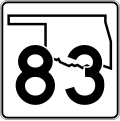Route description
SH-83 begins at US-59 north of Howe. The route heads due east of this point, continuing until it reaches an abandoned rail line, where it curves north. SH-83 follows the rail line as the highway turns back east, paralleling Sugar Loaf Creek. The highway enters Monroe, where it forms the north edge of the town. After leaving Monroe, SH-83 turns northeast, away from the railroad. As it angles to the northeast, the route crosses Cowskin Creek, a tributary of Sugar Loaf Creek, before crossing Sugar Loaf Creek itself. SH-83 then returns to a due east course. The road passes south of Sugar Loaf Mountain, elevation 2,564 feet (782 m). [2] The route then turns northeast just before crossing the state line into Sebastian County, Arkansas, where SH-83 ends. The roadbed continues as Arkansas Highway 96.
This page is based on this
Wikipedia article Text is available under the
CC BY-SA 4.0 license; additional terms may apply.
Images, videos and audio are available under their respective licenses.

